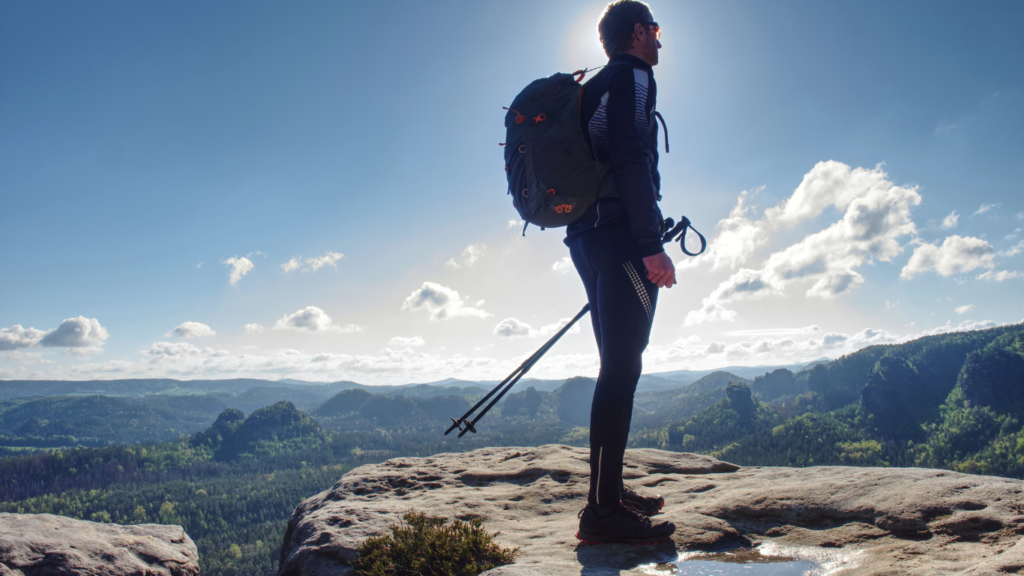The Importance of Hiking Poles
Hiking poles enhance balance and stability on rugged terrains by reducing stress on the joints. Studies from the American Hiking Society indicate that using poles can reduce the impact on knees by up to 30%. This reduction is crucial when navigating steep descents, uneven paths, or slippery surfaces.
Another advantage is improved posture. Poles encourage an upright stance, which helps distribute weight evenly and lessen fatigue. This aspect is significant during long hikes, where maintaining proper posture can prevent back and neck pain.
Poles provide support during river crossings, as well. They offer additional balance, making it easier to navigate fast-flowing water and slick rocks. This support can be particularly beneficial in unpredictable weather conditions.
Using poles also increases calorie burn. According to research, hikers using poles burn 20% more calories than those who don’t. This increase is due to the upper body engagement, which turns a lower-body workout into a full-body exercise.
In wildlife areas, poles can serve as a deterrent for animals. The extra noise and movement alert wildlife of your presence, reducing the likelihood of surprise encounters with potentially dangerous animals.
Hiking poles also help in reducing swelling in hands. By keeping your hands elevated, they prevent blood from pooling, which often occurs during long hikes without poles. This aspect is often overlooked but is very beneficial.
Table summarizing benefits of hiking poles:
| Feature | Benefit |
|---|---|
| Joint stress reduction | Reduced knee impact by up to 30% |
| Improved posture | Even weight distribution, less fatigue |
| River crossing support | Better balance, easier navigation |
| Increased calorie burn | 20% more calories burned |
| Wildlife deterrence | Alerts animals, reduces encounters |
| Swelling reduction | Prevents blood pooling in hands |
Using hiking poles offers multiple benefits that contribute to a safer, more efficient hiking experience on rugged terrains.
Key Features to Look For in Hiking Poles
Choosing the right hiking poles ensures safety and stability on rugged terrains. Here are essential features to consider:
Material and Weight
Hiking poles often use materials like aluminum or carbon fiber. Aluminum poles, known for durability, weigh more compared to carbon fiber poles. Carbon fiber poles are lighter but can be less durable. Opting for lightweight material minimizes fatigue during long hikes.
Grip and Straps
Grips are typically made from cork, foam, or rubber. Cork grips adapt to hand shape over time and reduce vibration. Foam grips offer comfort and moisture wicking, while rubber grips provide a solid hold in wet conditions. Straps help maintain control and reduce wrist strain, especially on steep ascents or descents.
Adjustability
Adjustable hiking poles accommodate different terrain and user height. Telescoping poles, which collapse into segments, or folding poles, which break into smaller sections, offer versatility. Adjustable poles allow for quick length changes, enhancing stability on uneven ground.
Shock Absorption
Shock absorption systems reduce impact on joints. Internal springs or built-in shock absorbers lessen strain, especially on downhill sections. Consider poles with this feature if joint protection is a priority.
Top Hiking Poles for Stability on Rugged Terrains

Selecting the best hiking poles ensures stability on challenging trails. Below are top choices, each providing unique features for rugged landscapes.
Pole 1: Black Diamond Trail Ergo Cork
Black Diamond Trail Ergo Cork poles offer excellent stability with an ergonomic design. The cork grips mold to hands, providing comfort over long hikes. Aluminum shafts ensure durability without excessive weight. FlickLock adjustability allows quick length changes, catering to different terrains.
Pole 2: LEKI Micro Vario Carbon
LEKI Micro Vario Carbon poles combine lightweight construction with strength. Carbon fiber shafts reduce weight, making long treks less tiring. The Thermo Mid grips offer comfort, even in cold conditions. Speed Lock 2 system ensures fast adjustments, crucial for varying slopes.
Pole 3: Foxelli Carbon Fiber Trekking Poles
Foxelli Carbon Fiber poles are budget-friendly without compromising quality. Carbon fiber shafts provide a good balance of strength and weight reduction. Anti-slip cork grips ensure a firm hold, even when sweating. The quick-lock mechanism allows easy modifications, adapting to any rugged terrain.
Pros and Cons of Popular Hiking Poles
Hiking poles come with various advantages and disadvantages. Below, I’ve listed the pros and cons of the top hiking poles for stability on rugged terrains.
Pole 1: Black Diamond Trail Ergo Cork
Pros
- Ergonomic Grips: The cork grips conform well to hands, reducing fatigue.
- Adjustability: The flick-lock system offers easy length adjustments.
- Durability: Aluminum construction ensures lasting sturdiness.
Cons
- Weight: Heavier compared to carbon fiber options; noticeable on long hikes.
- Shock Absorption: Lacks advanced shock systems, impacting comfort.
Pole 2: LEKI Micro Vario Carbon
Pros
- Lightweight: Carbon fiber material makes it incredibly light.
- Compact: Collapses down small, ideal for traveling.
- Comfort: Foam grips provide a comfortable hold.
Cons
- Price: Higher cost due to carbon fiber material.
- Durability: Less durable than aluminum, prone to cracking.
Pole 3: Foxelli Carbon Fiber Trekking Poles
Pros
- Affordable: Offers good value for the price point.
- Weight: Lightweight, reducing overall carrying strain.
- Shock Absorbers: Built-in shock absorption improves comfort.
Cons
- Grip Durability: Rubber grips wear out faster compared to cork.
- Stiffness: Some users find them overly stiff, impacting flexibility.
How to Choose the Right Hiking Poles for You
Selecting the right hiking poles enhances stability and comfort on rugged terrains. For the best results, consider your specific needs and try different poles before finalizing your choice.
Assessing Your Needs
Begin by identifying your primary hiking environment. If you hike on rocky trails, look for durable poles with reinforced tips. For snowy or slippery conditions, poles with wider baskets work better. Consider the frequency and duration of your hikes. Lightweight poles like carbon fiber suit long treks, while aluminum provides added strength for shorter, rugged hikes. Evaluate your physical needs. Adjustable poles accommodate varying terrains and personal height, offering versatile support. Shock-absorbent features are beneficial for those with joint issues, reducing impact on uneven surfaces.
Trying Them Out
Visit a store to test hiking poles in person. Check the grip comfort. Ergonomic handles, such as cork or foam, prevent blisters and offer a firm hold. Adjust the poles to your height; your elbow should be at a 90-degree angle. Experiment with the locking mechanism. Twist-locks and lever-locks should be secure and easy to use. Walk around the store to sense the pole’s weight and balance. Lightweight poles reduce fatigue over long distances, whereas heavier poles provide stability on tough terrains.


























































































































































































































































































































































































































































































































































































































































































































































































































































































































































































































































































































































































































